Traversing the Steppe
The silence of the steppe was overwhelming at first. I left the congested chaos of Mongolia’s capital Ulaanbaatar behind, and the sky took over. Buildings faded away behind me, consumed by the open space.
For the self-sufficient crossing, I had come laden with approximately 60 pounds of gear, water, and food on my trusted steed, a fully rigid Thorn Nomad equipped with 2.15in. Marathon Mondial touring tires. With the vast majority of the country composed of dirt roads and horse trails with no signage to help a traveler out, I prepared with a compass and GPS. I had never wild camped on my own before, but in Mongolia, apparently, I could pitch my tent almost anywhere for there was almost a complete lack of private land. It was in line with the nomadic way of life.
As I pedaled farther from the city on one of the few paved roads, it was hard to comprehend that I had actually made it here, to Mongolia. I was a nonexistent speck on that glossy map. I was riding into a big emptiness and a strong headwind. Open steppe expanded endlessly away from the pavement, still dotted with patches of snow, few vehicles, and even fewer dwellings.
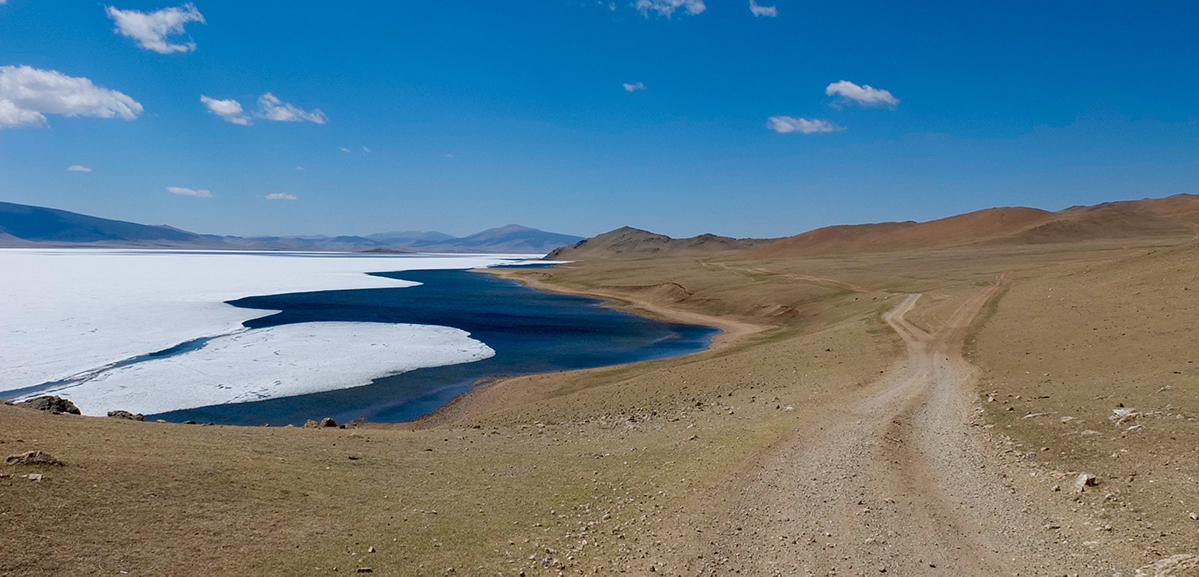
Soon, nighttime approached. I could feel a tightness in my chest. I spent an hour scanning either side of the road for some kind of hill to hide behind. Eventually, I spotted a ger in the distance, a Mongolian-style yurt. I had read about other people camping near gers for added security. I worked up the courage to approach the dwelling. A few dogs ran out and barked. An older woman emerged alone. At this point, I could only say maybe five words of Mongolian, and the written language using the Russian Cyrillic alphabet posed a similar challenge.
“Sain Banuu!” (Hello!) I called out. I made a triangle-type gesture for “tent” and leaned my head onto clasped hands for “sleep.” She looked somewhat confused and motioned for me to come inside. The woman was dressed in Western-style clothing instead of the traditional Mongolian robes I had seen in photos. She served me a traditional tea called suutei tsai: green or black tea, milk, and salt, and occasionally with butter or mutton fat. I enjoyed it immensely. After preparing the tea, she got to work on a meat stew. Her hands were dense and strong but floated between tasks with effortless grace. She stirred the large pot in a steady rhythm. I fell into a trance just watching her, the smell of the meat stew filling the ger.
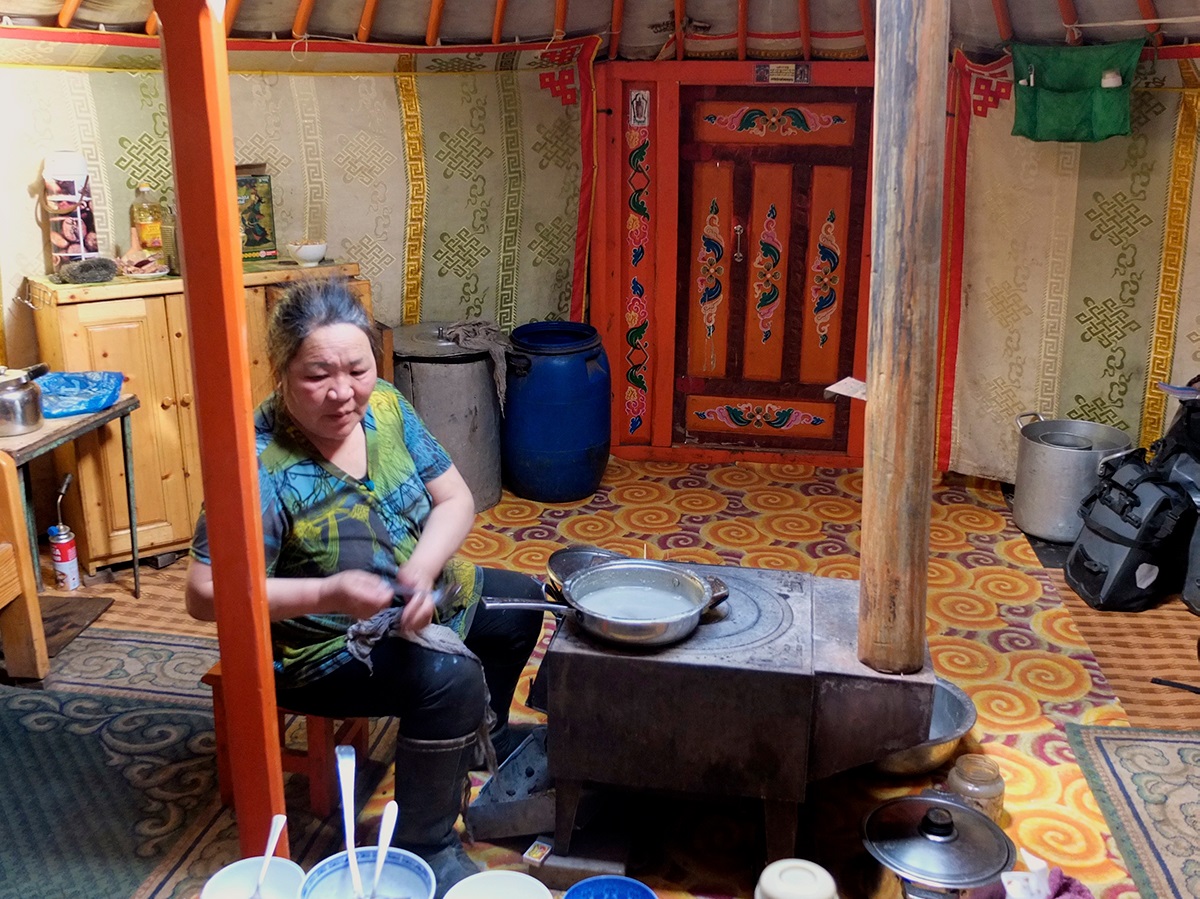
We ate in silence. The mutton stew was rich, salty, and filling. I wondered how long my host had been on her own and if she had a family. Weariness was etched into her eyes, and she moved with a heavy gait that seemed to sink into the earth. She gave me a wooden platform to sleep on, with comfortable carpets for a mattress. It was a warm ger nestled under a cold blanket of stars.
Even though I was alone, it wasn’t often that I went unseen. Sheep were everywhere. And what felt like out of nowhere, a friendly local would approach me on motorbike or horseback to chat or invite me into a ger for tea.
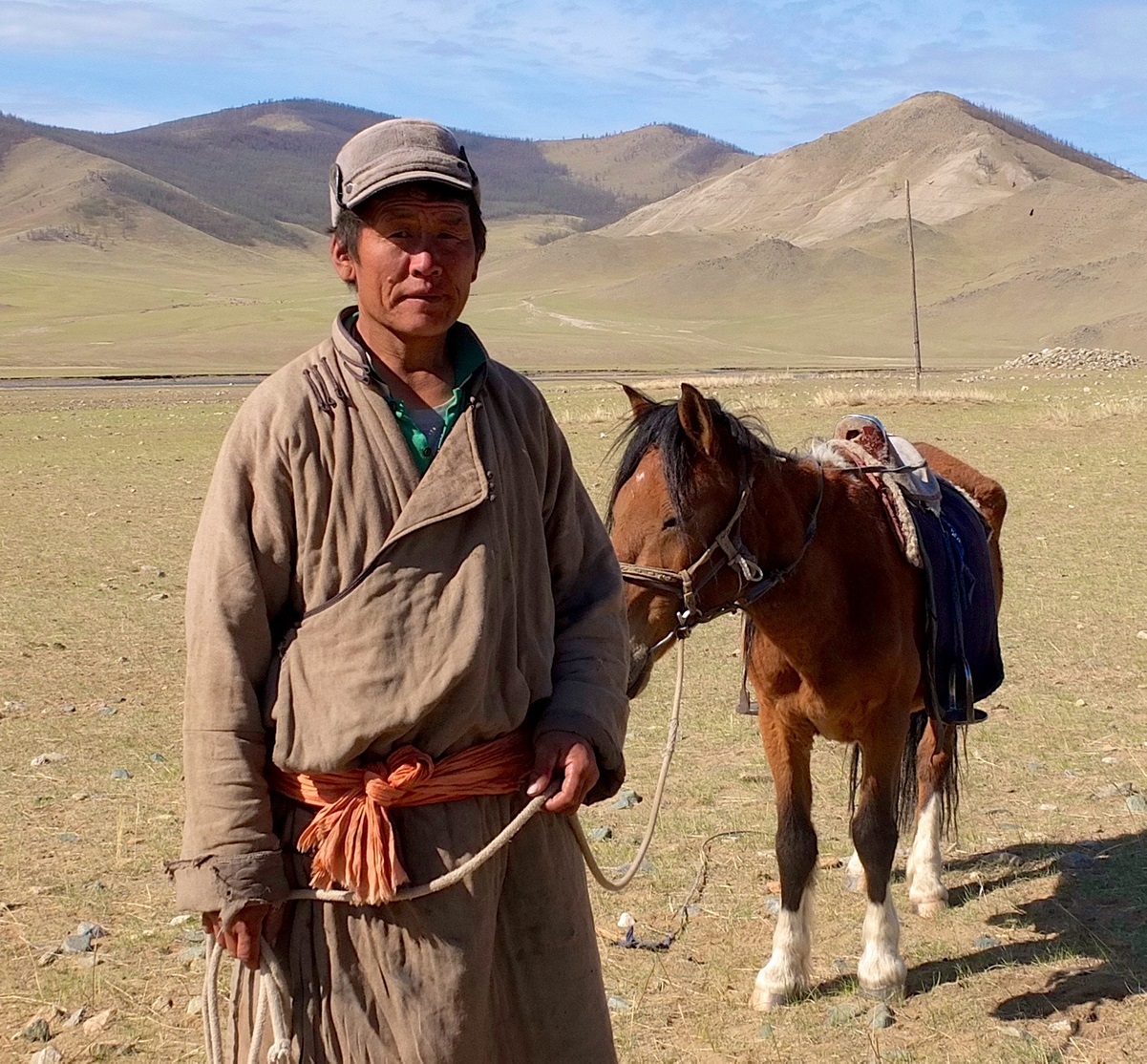
On the evening of the second day of riding, the skies turned a dark grey and the temperature plunged. Snow came and I hurried to set up my tent before it grew heavy. It didn’t take long before a man on a motorbike with a small child on his lap approached me. He looked at what I was doing and shook his head and pointed to another ger in the distance. I got the hint that he wanted me to stay with his family. I hesitated at first, but he insisted. He even tried to help me pack up my tent. Soon, I was in front of a woodstove with a hot cup of milky tea in my hands. The taste of salt and fatty milk was a warm hug. With only a few words of Mongolian in my repertoire, first interactions were always awkward. I had my Lonely Planet phrasebook, which I used to point to phrases in Mongolian. In exchange, my hosts would take the book and do the same. It became sort of a fun game. Fingers would often point to the same questions:
Are you married?
Do you have children?
Is your mother worried?
Are you scared?
I was also carrying a “magic letter,” a genius idea by the famous British bicycle traveler Alastair Humphreys. I had this letter translated into various languages and would present it to my hosts:
Dear Friend,
I am a Canadian cycling around the world. My route is taking me across Asia from Mongolia to Uzbekistan and then into Africa from Cairo to Capetown. The journey will take approximately 18 months and will cover around 25,000 km. I am travelling slowly by bicycle as it gives me time to enjoy your beautiful country.
I am writing to my friends and family in Canada about my trip and will enjoy telling them about your culture and meeting local people. I am able to travel cheaply as I have everything I need on my bike including a tent and cooking equipment.
I am excited to be riding across your country, and I apologize for not being able to speak your language.
I hope that you can help my journey to continue safely and happily.
Thank you.
With warmest regards,
Tara
I was given a massive plate of tsuvian (“tuh-van”) by my host’s wife, a traditional dish with fresh noodles, onion, and mutton. It was cycling superfood, heavy, greasy, and calorie-rich. The setup in the ger was very similar to where I had stayed the previous night. Rich carpets decorated the walls with wooden cots for beds. There were some framed family photos of people dressed formally in front of Ulaanbaatar’s capital building, which was a common decoration. I soon slept soundly on a bed of carpets while the wintery weather continued through the night, threatening the progress of spring.
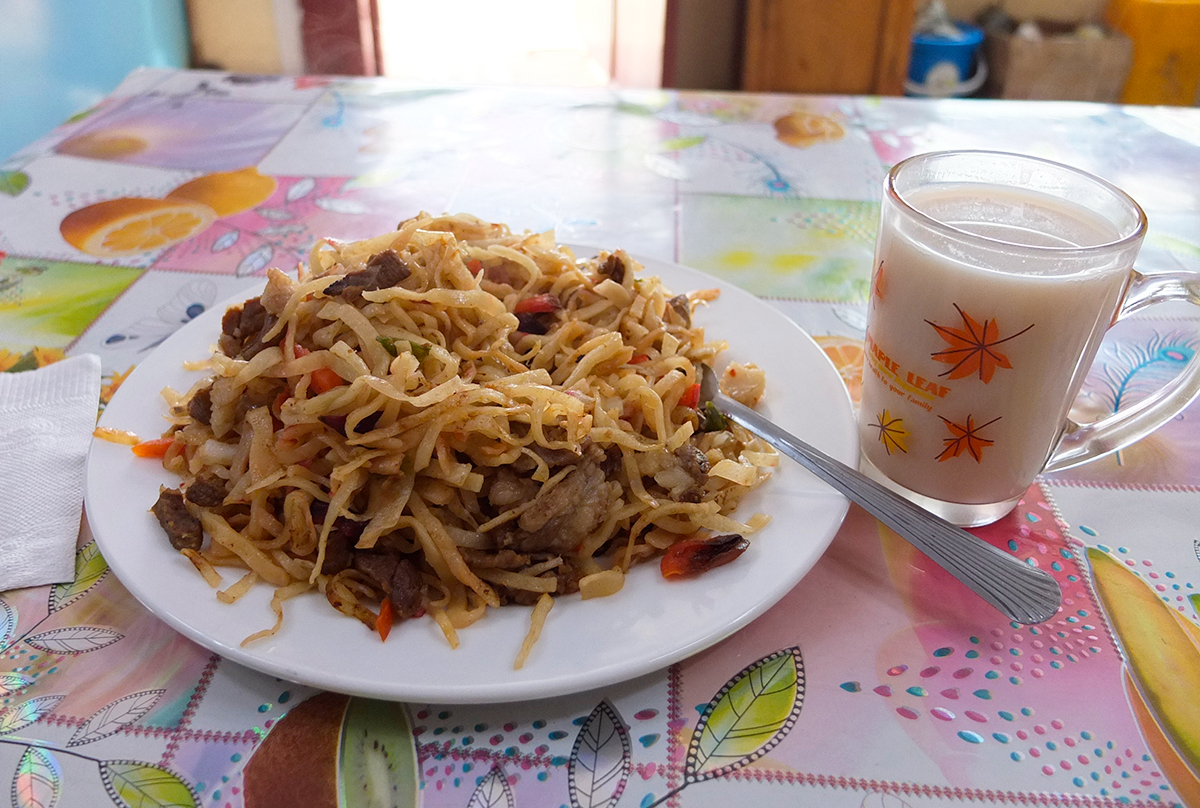
I spent the next morning playing with the small boy in the snow just outside of the ger. Out in the chilly air, his father reached out to touch my thin Gore-tex jacket and shook his head, pointing instead to the thick traditional robe he was wearing, a deel. The deel is a loose calf-length tunic made of a single piece of material. It has long sleeves, a high collar, and buttons on the right shoulder. Each ethnic group living in Mongolia has its own individual deel, distinguished by its cut, color, and trim. It was certainly better suited to the early spring conditions but unfortunately not very packable for a touring cyclist.
I took some photos with the family, wishing I had some sort of Polaroid setup so I could give them some in return. I offered a small amount of money as I left, which I was told was good practice. The weather was cold and blustery outside, but the lure of the open road was ever present. The path ahead stretched on toward turbulent skies and an indefinite goal lost in the steppe.
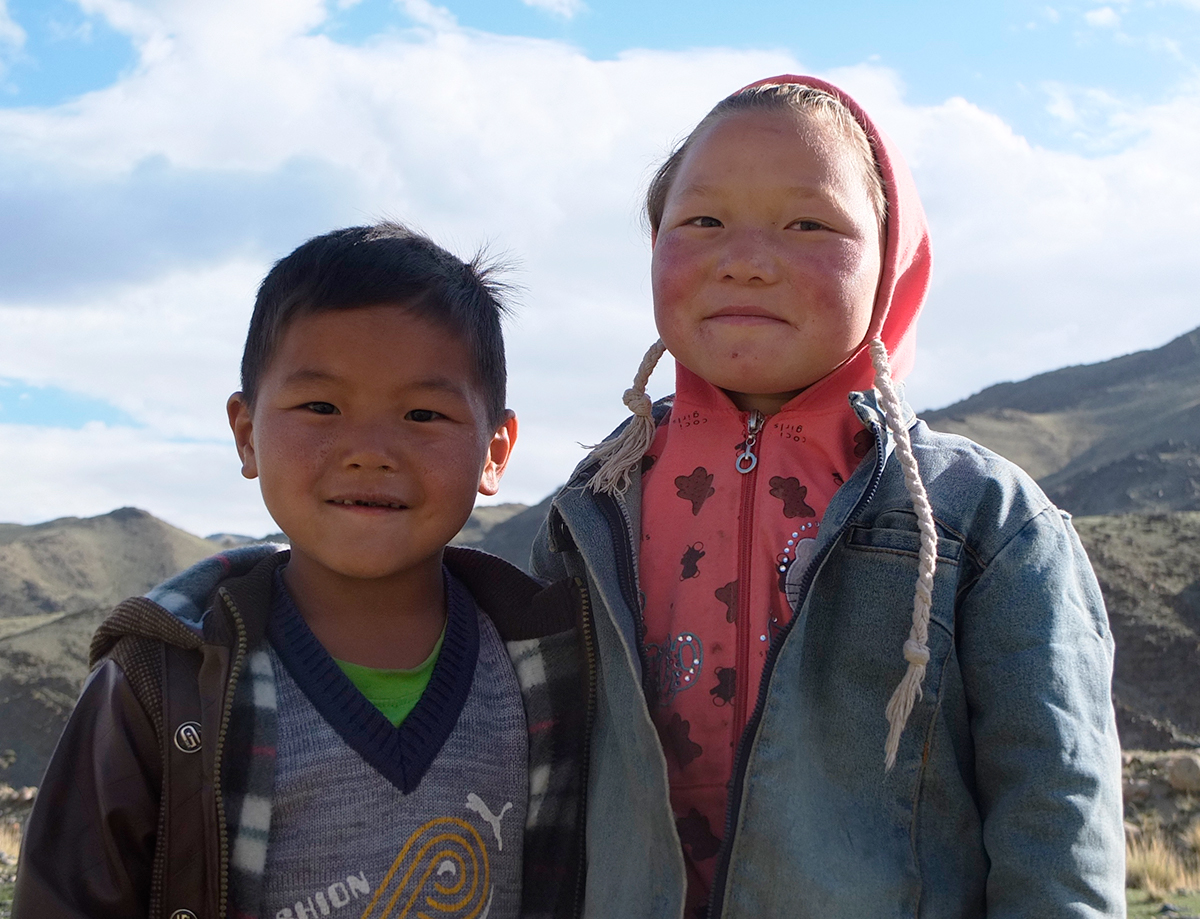
In small settlements, I would resupply for the next remote stretch or get a heaping plate of tsuvian from a restaurant. I seldom desired to linger. With the desertification of the grasslands occurring due to climate change, sheep populations and the Mongolian traditional way of life are being threatened. As a result, more and more of the population are migrating to these towns, which often lack opportunity or the chance to utilize the skills developed for a life of living off the land. In town, alcoholism was a noticeable issue, and there were moments when I didn’t feel the most comfortable.
The wind continued with brute force, and I sometimes only covered 25 miles in a day. Just outside of Jargalant, the sun cast golden rays on a rich carpet of stunted green grass. Smooth stretches of dirt tracks lay tangled among themselves, chaotically swerving in unknown directions. Without road signs, I could understand why GPS was so advised here. When I felt truly lost in this wilderness, a friendly nomad would ride over the hills on horseback to greet me. One time, a man helped me carry my bike across a rushing stream. Another sat down with me for lunch, taking my offering of bread but not peanut butter. The hospitality in Mongolia became difficult to escape. Some nights I would even try to hide from others to get some more alone time but more offers of a warm ger continued to come my way.
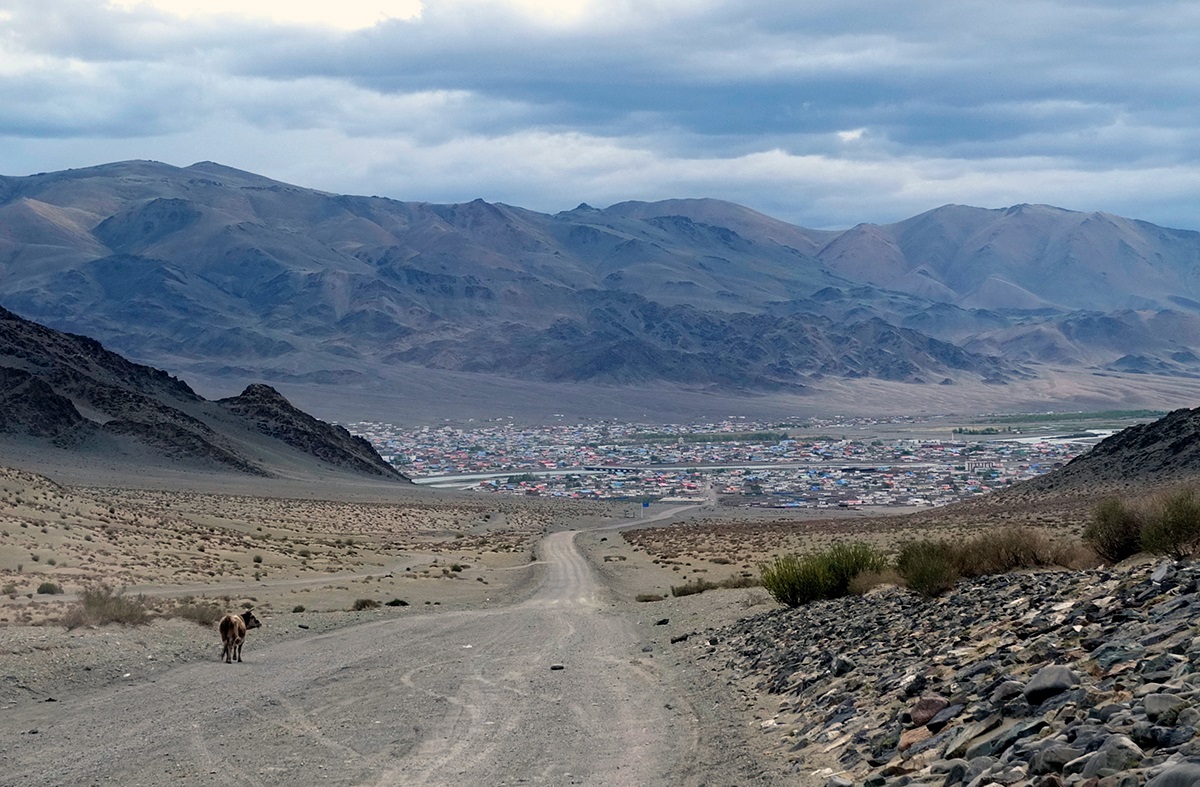
The sounds of sheep herds passing became my alarm clock each morning and my main company, along with some lazy-eyed, dreadlocked yaks. I fell into a beautiful rhythm of waking to the voices and whispers of the steppe and riding out into its endless horizon.
Green grass morphed into dry desert as I made tracks towards Khyargas Nuur (nuur is Mongolian for lake), where I was greeted by nosy camels at its shore. The sand coated my skin and panniers in a semi-permanent layer. I loaded my bike with 10 liters of water to get me across to Ulaangom in the Uvs province.
The track from Ulaangom had me crossing the Ulaan Davaa (Red Pass), which turned out to be one of the toughest stretches of my Mongolia adventure. I spent hours pushing and dragging my bike up a steep and rocky track. I knew the summit was near when I spotted the ovoo — a type of rock cairn and traditional Mongolian shamanistic offering to the gods, usually made of nearby rocks, wood, and strips of colourful silk. It brought back the feelings of reaching high summits in Tibet and Nepal, with prayer flags flapping in the wind. The hills around the pass were awash in a reddish hue, thus the name “Red Pass.” I pushed out a smile through laboured breaths and began the descent into a land of lush green and mountains.
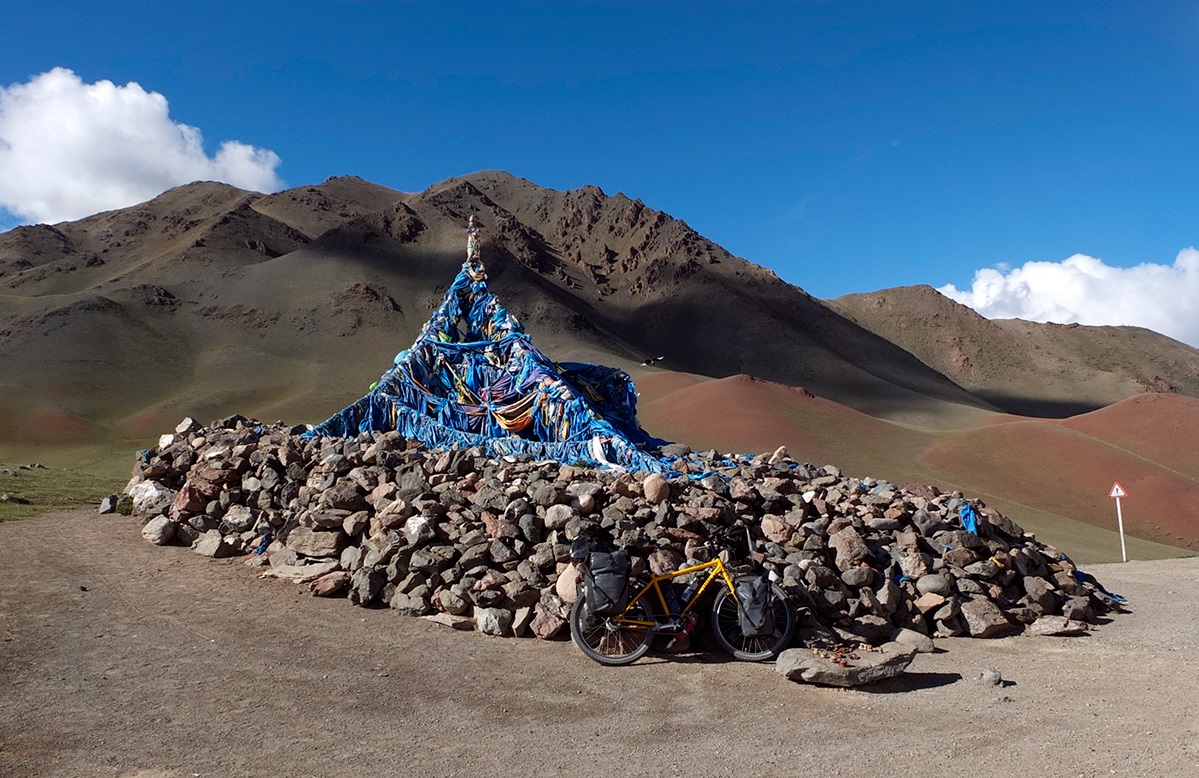
The dirt tracks carved a wavering path through snow-capped peaks. With my head lost in the magnificence of it all, I was a bit shocked by a German motorcyclist coming my way, wearing a blindingly white Red Bull riding suit, GoPro-equipped helmet, and rainbow iridescent goggles that I could see my own reflection in. It was like running into an astronaut.
“Where are you going?” he asked.
“Across Mongolia and other parts of Asia,” I replied.
“On that?” he said, with a strong hint of doubt.
“Yes.”
“Why? It’s too slow.”
And that was the extent of the conversation. We wished each other good luck, and I continued onward, the slow way.
The ovoo at the Bairam Davaa pass signaled the high point of the Mongolia crossing at 2,570 meters. The scenery changed from a lush, green steppe to a barren, volcanic landscape. I passed the mining community of Khotgor. Another rocky, blackened track took me through a surreal landscape of hilly desert and ash.
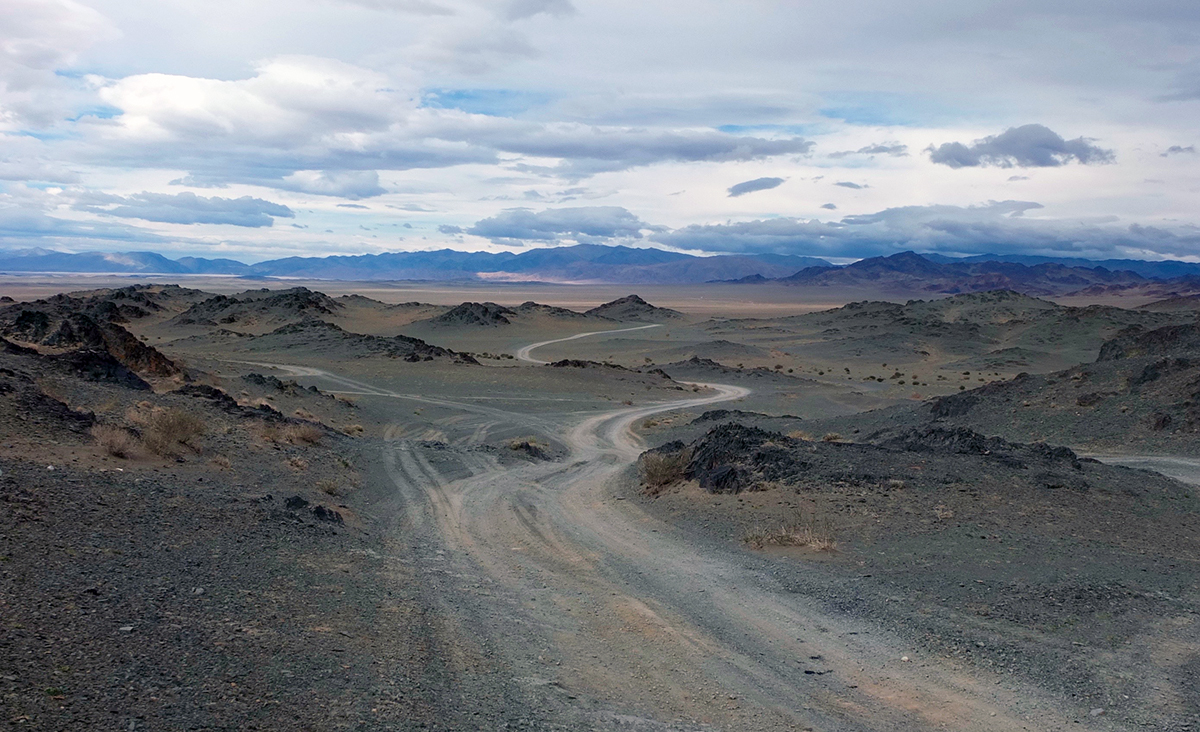
Not long after I pitched my tent, a hauntingly beautiful woman appeared on horseback, gliding across the sandy bank as if in a dream. She was regally dressed in bright orange robes with a traditional pointed red hat. She had long black hair. She stopped and stared at me piercingly. Then she turned forward and her horse continued with a slow walk farther and farther down the shore of the lake. I felt as if I had seen a ghost from the past. From the shore of the lake, I could see the landscapes of desert, water, and mountain coexisting, stacked in layers. The faded light brought out their strongest hues. I crawled into my tent, lulled to sleep by the gentle rippling of waves along the shore.
A few days later I reached the larger town of Ölgii. The Bayan-Ölgii province is largely Kazakh with a decent percentage of the population practicing Islam instead of Buddhism or Shamanism. I was also now in the realm of eagle hunters, a 4,000-year-old tradition in western Mongolia.
Near the tiny town of Tolbo, I was stopped again by a family as I tried to pitch my tent. Just outside of their small dwelling, I spotted a golden eagle tethered to a pole. I had found real eagle hunters! There was a young boy, probably not much older than 10, who motioned for me to come over to where the eagle was perched. He put a decorated leather sleeve on his arm, grabbed the rope tied to the bird’s leg, and held her down firmly on his arm. He then put her back onto the fence where she was perched and handed me the sleeve to try. I put the sleeve on my arm, lowering it toward the bird. He handed me the tether, and I gripped it firmly. I couldn’t believe how heavy the bird was. When she stretched out into her full wingspan, it was both frightening and exhilarating. The boy found my camera and took many photos. At the end, he reached his hand out, asking for a tip for his work. I guess I wasn’t the first tourist to pass through and I happily rewarded the young man.
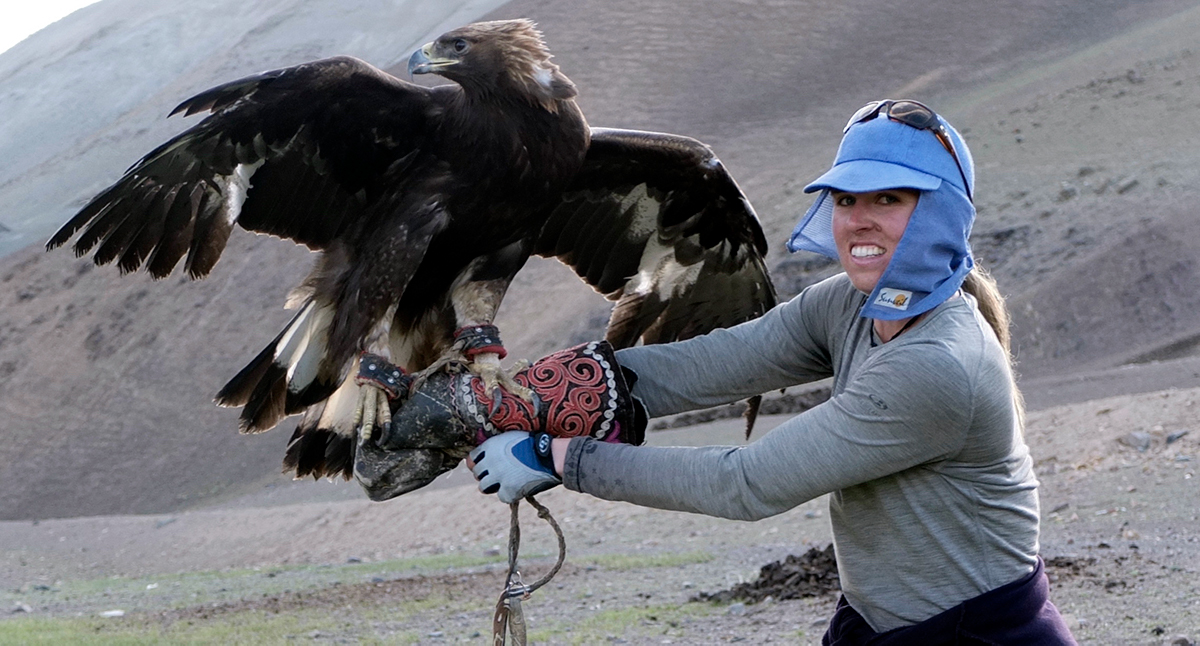
Soon, I was invited into the family’s home for some welcoming snacks, tea, and vodka shots. I had a late-night feast of my beloved noodle dish, tsuivan, Kazakh-style, and slept well on the floor that night, sheltered from the wind howling outside.
The following morning, still excited by my encounter with the eagle-hunting family and leaving the town of Khovd, I was soon approached by a man waving on a motorbike. I had this happen many times before — a friendly local waving for me to stop and have a chat. But right after the man pulled up beside me, something didn’t feel right. I could see that he was drunk, and he kept saying one word over and over in Mongolian that I didn’t understand. I said “goodbye” and started to pedal away. The man reached out and stuck his hand between my legs and tried to pull me off of my bike. I pedalled hard, yelling and swearing, making a scene as much as I could. He trailed me briefly but eventually gave up and turned back toward Khovd. The feeling that arose in me was more anger than fear — how dare he. In my many years of travelling solo, it’s the only really bad encounter I’ve had, and I couldn’t let it ruin my opinion of Mongolia. I had already experienced so much kindness. I still camped alone that night but maybe not as comfortably as before.
Not long after, I ended up having one of the best moments of the trip. I was days away from the Chinese border in the town of Uyench, looking for somewhere to pitch my tent. I saw a woman playing with a very young girl in a fenced yard with a tiny house. We waved to one another. Once we started interacting, there was an instant connection, even without a common language. She invited me into her home and poured me some suutei tsai. She refilled the cup so many times that I lost count and she was thrilled to see that I enjoyed the drink so much. I showed her my “magic letter,” and we enthusiastically passed my phrasebook back and forth, trying to build our own stories for one another.
She told me that a typical salary for a Mongolian is only $250–$350 USD per month. In the country, Mongolians are largely self-sufficient, raising their own animals and fueling the gers with dung. With a move into a town, it becomes much harder to make a living. When I asked if she was married, it was devastating to hear that she had lost her husband in a car accident only the year before, from drinking and driving. With all that this woman had been through, it seemed that she had so much to give, even to a total stranger like me.
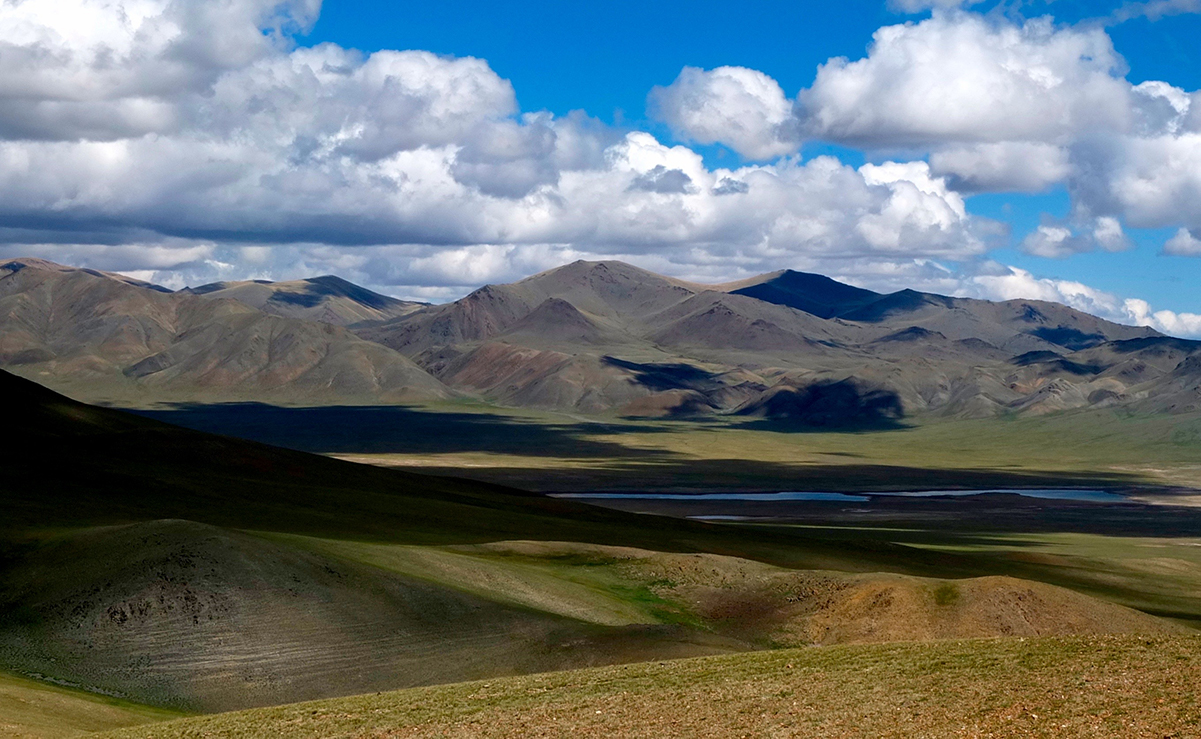
I camped in her yard that night, and she and her daughter slept in her small car. I imagined she didn’t want to sleep in her own bed because of the memory of her husband. As I rode on toward China the next morning, I couldn’t get her out of my head.
My last night in Mongolia was of course spent in another ger, after a kind family thwarted my attempts to set up my tent for the millionth time. I dined inside with multiple generations — grandparents, parents, and children, surrounded by the usual photos of the family dressed up at the capitol building in Ulaanbaatar. This time we were having buuz, dumplings filled with mutton. I watched them fold and crimp together dozens with fresh dough. They were boiled in a pot on the woodstove and were delicious, accompanied by the usual endless amounts of salty milk tea.
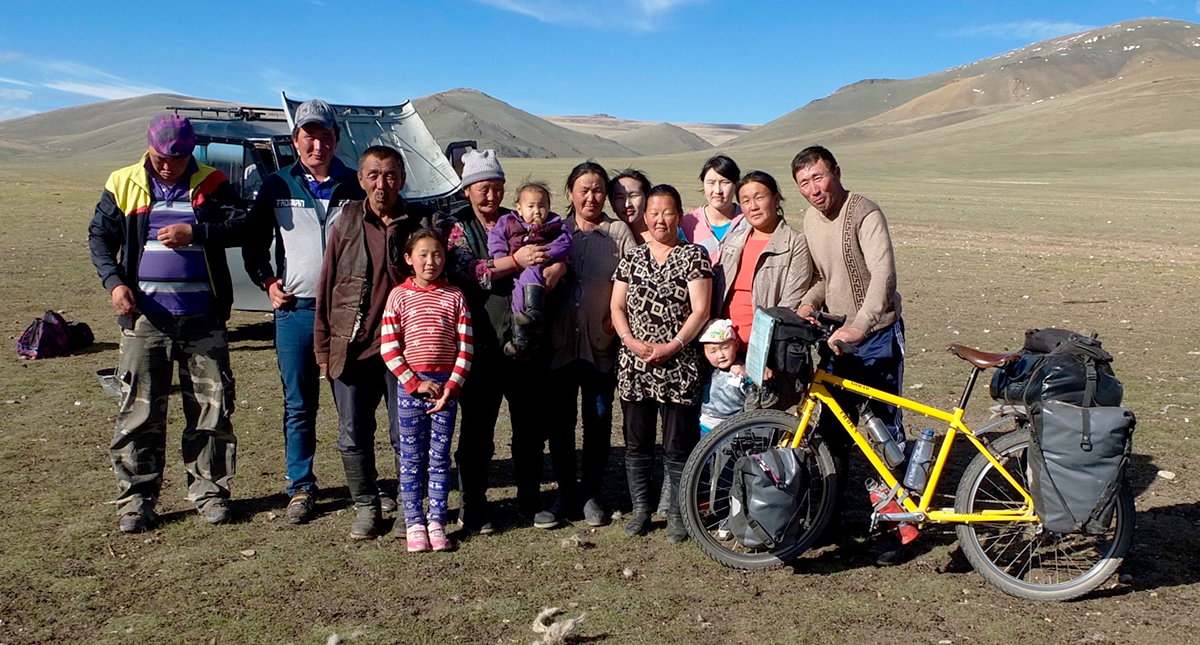
Life inside of a ger is vibrant. With only one communal space, it is important to live together in harmony. There was no “my property versus your property;” this land was shared. For me, my experience with the people of Mongolia was just that: shared. The next morning, I waved goodbye to my final hosts, and in the tradition of a nomadic country, I hit the road.

